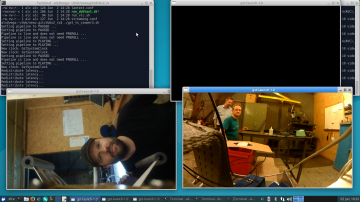On thinking outside the (original) box.
It takes a fair amount of time to arrange and set up cameras for a motor test or other kind of test here at CS. A lot of doublesided self adhesive pads are used to place the black plastic mounts holding the waterproof housings for the CCC(Z) and GoPro cameras more or less everywhere.
The CCCZ camera doesn’t fit in the original housing at all, but is placed at some distance from the center of events, which makes using it without a protective casing acceptable. But during the upcoming launch events in the Baltic Sea it would be preferable to protect the CCCZ from salt water, rocket smoke and the likes.
This has led me to think outside the original box (or housing), and thus I have procured a large standard box for the CCCZ.
A 3D-printet special housing for the CCCZ is not considered feasible, as the required waterproof button actuators needed is unavailable to purchase in small numbers.
And as Sputnik has lots of railing to mount the box on, and work space is not an issue, a larger sized box doesn’t present any problems.
Panoramic window and an ocean view.
There’s no need to go to extremes though, the box chosen measures 16x16x9 cm. It also has a transparent lid, as otherwise the project would be rather pointless.
There’s amble room for the CCCZ, but a lot of other paraphernalia will go in as well, making it a bit crowded in the end.
First of all a vibration damping mount is placed as a base. It’s really made for an RC helicopter, but the camera doesn’t know that. A ball head camera mount goes on top of the damping mount, allowing pan and tilt of the camera.
The lower mount is attatched to the box via an excentric joint, to allow the camera position to be adjusted depthwise. This is needed as the depth of the box is smaller than wished for, but the largest depth available.
A power bank with two 18650 Li-Ion cells goes over the camera, at the top of the box. The video techs will be ushered off the platform a long time before the rocket is launched.
This mandates that the fully charged internal battery, allowing 20-25 minutes of runtime, is backed up by an external (to the camera) power source, to allow a sufficient runtime.
The chosen power bank provides a runtime of at least four hours. If four hours are not enough, we have other and more severe problems to attend to.
The power bank is charged via a waterproof connector mounted in the sidewall of the box.
To ease mounting on the railing, with cable ties or the like, an L-shape aluminium profile has been attached to the back of the box.
Cable spaghetti
All connectors are situated on the back of the camera, making it hard to access these without turning the camera around, thus losing the motive frame adjustment.
This is solved by procuring short adapter cables for the connectors needed to interface the camera during use, to make connecting to the HDMI, and inserting or removing the memorycard possible, right behind the front lid.
The camera’s microUSB connector is connected to the power bank.
Thumb screws.
To avoid having to bring, or find, a screwdriver to remove the box lid, the normal phillips head screws supplied with the box have been exchanged with thumb screws.
In an attempt to avoid the thumb screws being lost at sea, they have been fitted with a groove and washer, to keep them attached to the lid.
A couple of spare thumb screws have been fitted in a holder inside the box, just to be on the safe side.
Below you will find some documentary pictures describing the creation of the camerabox.
First the parts used: Power bank with 6 Ah capacity (with cables soldered directly to the circuit board, in place of the original USB connectors), adaptercable for the memorycard, damping and ball mount combination, adaptercable for the HDMI monitor and last all parts ready for mounting in the box.
All parts, apart from the charging connector, are mounted using soublesided selfadhesive foamtape. First the power bank, then the adaptercables for memorycard and HDMI monitor, then the camera mount, the camera and a holder for the spare screws.
At the bottom the finished box with aluminium profile and lid fitted.
I’ve chosen to bother you with some selfies, taken with the CCCZ mounted in the finished box. As the railing on the launch platform isn’t within reach for the time being, a railing on the roof of a university building have been used instead.
And lastly, a comparative double selfie, taken with the original wide angle lens and the zoom lens respectively. The foggy pictures are taken with the lid mounted on the box, so a modification involving a clearer window is probably forthcoming.




